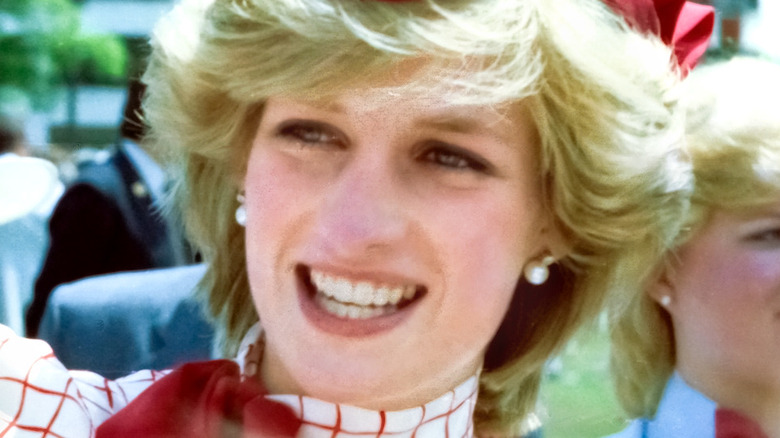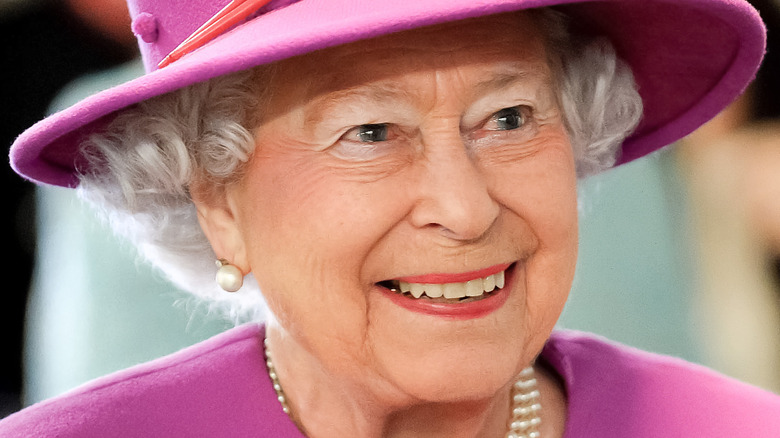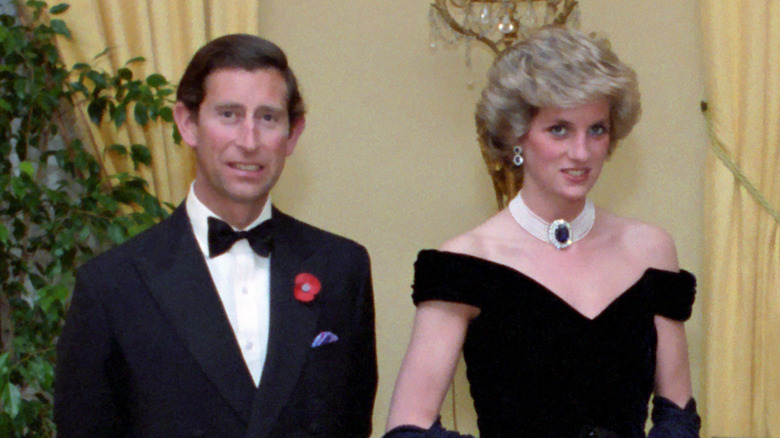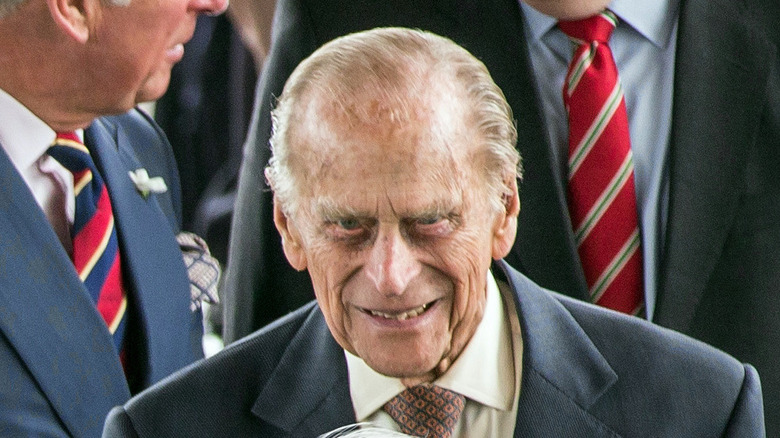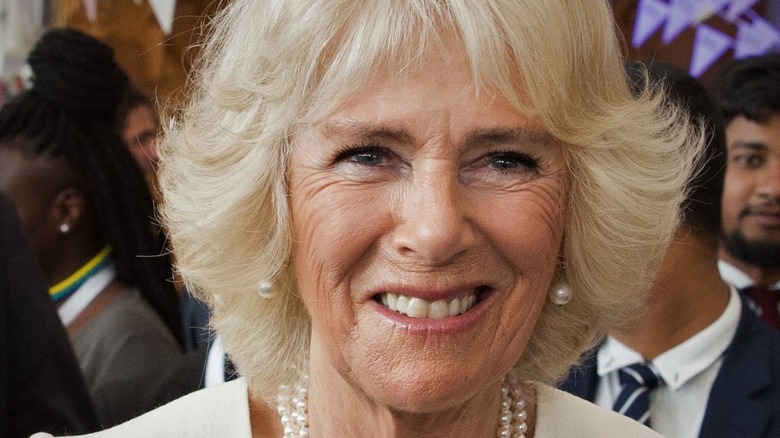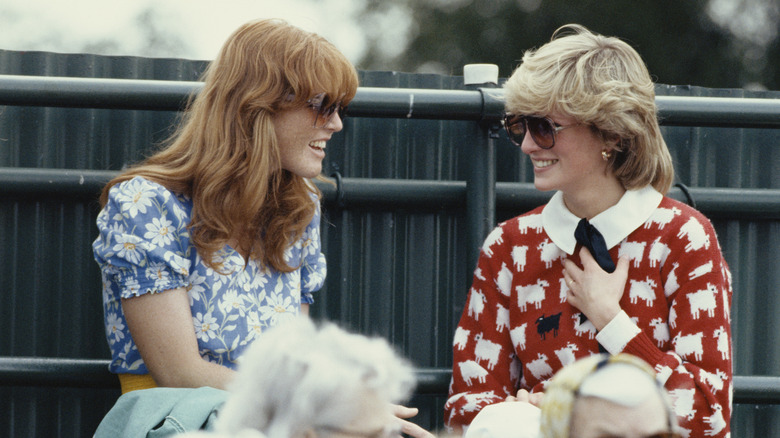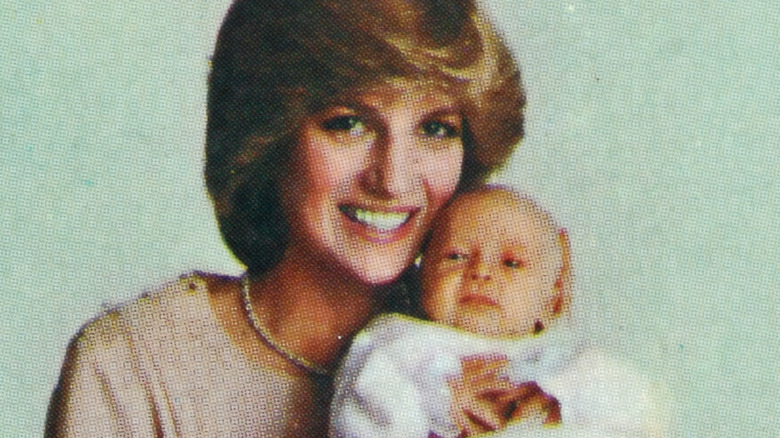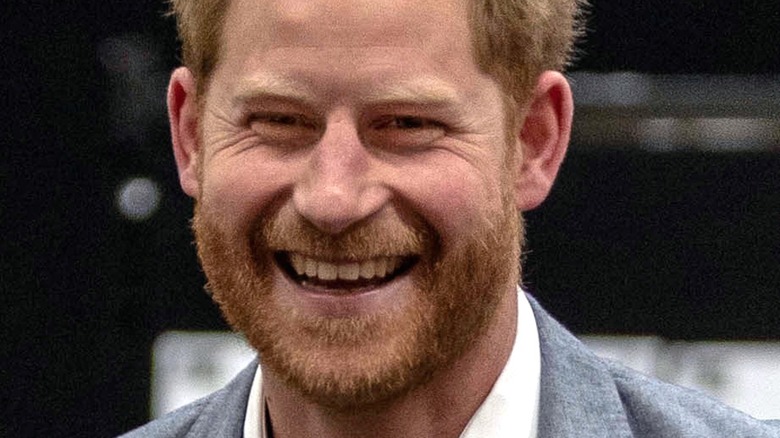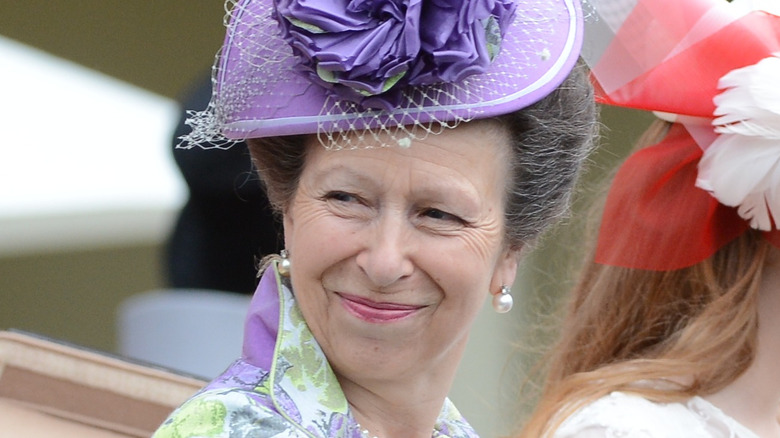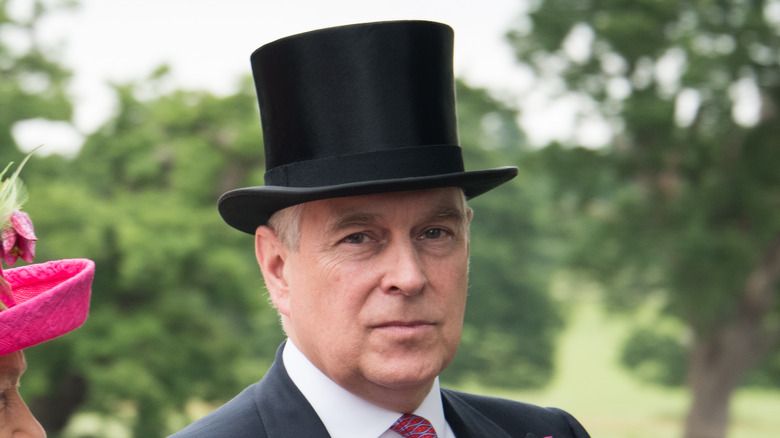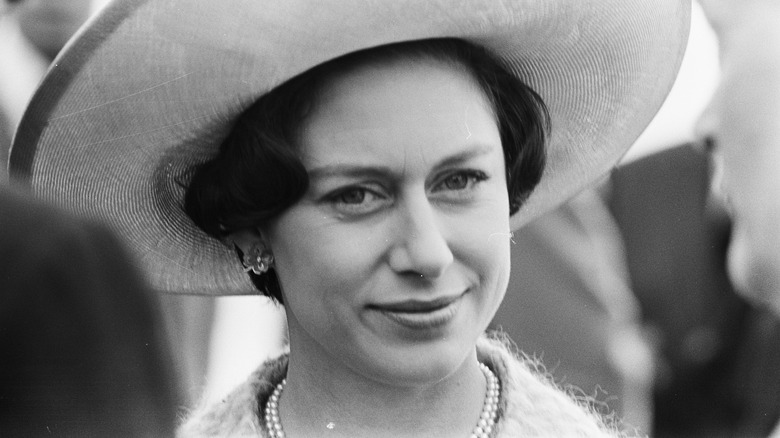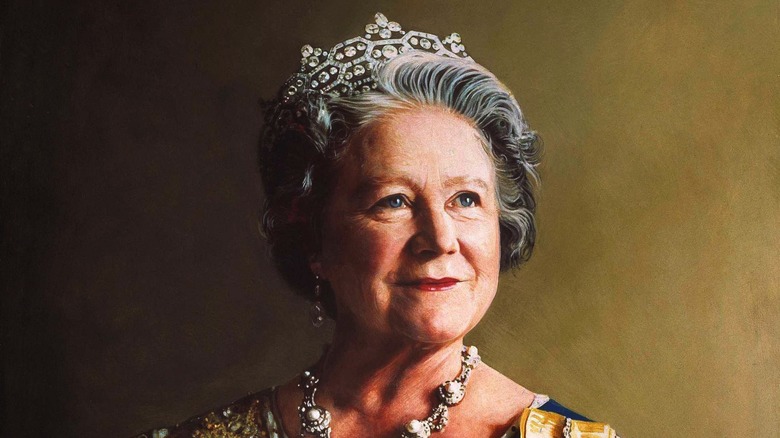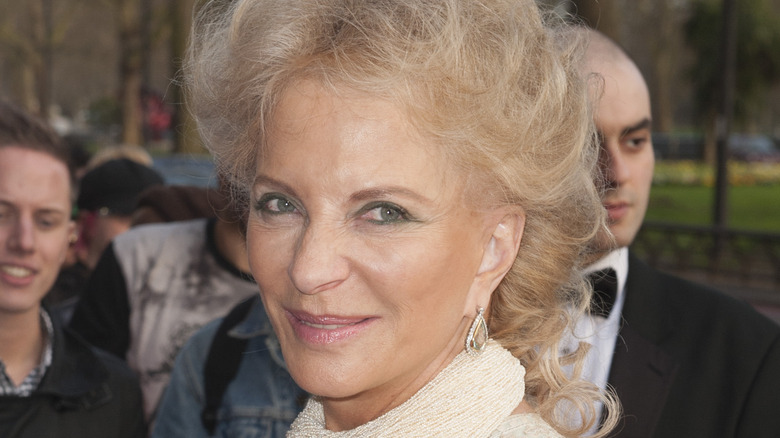The Truth About Princess Diana's Relationship With The Royal Family
When Lady Diana Spencer was first put forward as a potential wife for obstinate bachelor King Charles III, the royal family believed the 19-year-old would fit right into the fold. Or the Firm, as they call themselves. After all, Diana had practically grown up in the queen's back garden, in a house on the royal estate of Sandringham. Her family, the Spencers, had been close advisors to the British monarchy for centuries. Fans of "The Favourite" may know that Sarah, Duchess of Marlborough (Rachel Weisz) was Diana's distant relative. And Diana's grandmother Lady Fermoy spent more than 30 years as a loyal lady-in-waiting to the queen mother. Besides, Diana seemed so eager to please, they assumed she'd be no trouble.
However, Diana quickly proved that she intended to do more than cut ribbons, wave from a carriage and look nice in a tiara. Her shrewd manipulation of the media (which didn't always work in her favor) and airing of dirty royal laundry disgusted members of the family who had previously welcomed her. Her mistrust of Charles and his relationship with his mistress Camilla Parker Bowles (whom he would later marry) caused an irreparable split. But she also worked hard to build a relationship with her two sons, William and Harry, that marked her as the most motherly royal possibly in history.
Here's the truth about Princess Diana's relationship with the royal family, including all her in-laws, her beloved sons, and the most controversial princess.
The Queen
Much has been made of Queen Elizabeth II's treatment of Diana, both while the princess was alive and after she died. Queen Elizabeth II was never one for public displays of affection to her own children, let alone their spouses. However, she liked Diana: She had known her grandmother, Lady Fermoy, who was a lady-in-waiting to the queen mother. According to Reader's Digest, the queen believed Diana's aristocratic upbringing had prepared her for a role in the royal family. Even when it became clear that the new princess was finding the public scrutiny and arcane rules soul-crushing, the queen believed she just needed more time to adjust.
Diana started to rely on the queen for advice and support — but that was where their differences really showed. Whereas the queen had been raised to bury displays of emotions in the name of representing the Crown, Diana was a passionate person who couldn't hide how she felt as easily. The queen struggled with Diana's tearful outbursts.
Public focus on the contrast between the queen's stiff upper lip and Diana's warmth came to the fore after the latter's death. Grieving for the most relatable member of the royal family, the public read the queen's stoicism as heartlessness. However, the monarch showed her true feelings in an emotional — by her standards — speech delivered to the nation the night before the funeral, in which she described Diana as "an exceptional and gifted human being."
King Charles III
The story of King Charles' and Princess Diana's wedding, marriage and acrimonious divorce has become a reverse fairy tale. Kindergarten teacher/aristocrat marries handsome (to some) prince; moves to his castle (Kensington Palace, to be precise); becomes anxious and lonely when he abandons her for his mistress; and scandalizes — and then wins over — the nation when they divorce.
Charles and Diana met in 1977, when she was 16 and he was 29, and dating her older sister Sarah. Shortly after their engagement, Charles described her at that first meeting as "very jolly and amusing and attractive," according to Harper's Bazaar. Three years later, Charles was under pressure to marry. Specifically, an aristocratic virgin. He'd reconnected with Diana at a mutual friend's house, and she fit the bill.
However, before and during the marriage, Charles continued to communicate with his now-married ex-girlfriend, Camilla Parker Bowles. Diana was jealous of her husband's mistress — but Charles was also jealous of his wife. Crowds flocked to see vibrant, warm Diana, and were visibly disappointed if they got Charles instead. After at least one affair on both sides, several unenthusiastic attempts to reunite, and trading accusations in the media, the couple divorced in 1996. Following Diana's death, Charles accompanied her sisters to transport her coffin from Paris to Britain.
Prince Philip
Prince Philip was one of the few people at the center of the British royal family who wasn't born into the Firm. He was, however, a royal from birth: He was prince of Greece and Denmark until he renounced these titles in 1947 to marry then-Princess Elizabeth. (Upon their marriage, he became the Duke of Edinburgh, and in 1957, as queen, she bestowed the title of "Prince" upon him.)
Having once had to adjust his own expectations in order to find his place within the royal family, Philip understood Diana's frustrations with the seemingly endless traditions and rules she was expected to follow. He tried to support her. As People reports, in a series of letters the pair exchanged in 1992, Philip offered to give Diana advice on how to save her crumbling relationship with Charles — although he admitted, "I have no talent as a marriage counselor."
Diana responded warmly to Philip's missives, refuting this claim, saying she was touched, referring to him as "Dearest Pa," and signing off with phrases like "with my fondest love." However, one of Diana's confidantes later claimed that the duke wrote the princess two "cruel" letters in 1994. And royal historian Ingrid Seward told People that Diana found Philip "too judgmental." He was, after all, first and foremost interested in protecting the British Crown — not Diana.
Camilla Parker Bowles
Before Diana became aware that Camilla Parker Bowles was — as the princess later put it — the third person in her marriage, the two had a cordial relationship. Parker Bowles was a regular presence in King Charles' life, but Diana initially believed she was just one of his circle of friends. In 1980, during Diana and Charles' first official public outing together — at a polo match Charles played in — Parker Bowles accompanied the 19-year-old.
It wasn't until Diana and the king got engaged that he confessed that he and Parker Bowles had previously dated. Diana became increasingly suspicious, especially when she found a bracelet Charles had made for Parker Bowles. It was engraved with the initials of their nicknames for each other, Fred and Gladys.
Fans of "The Crown" will remember an awkward lunch between Diana and Parker Bowles. Parker Bowles (Emerald Fennell) offers Diana (Emma Corrin) advice about Charles, showing off her extensive knowledge of the other woman's fiancé, and casually ascertains when Diana won't be accompanying him. This scene is based on a real meeting, which Diana recounted to biographer Andrew Morton. Diana also said that she confronted Parker Bowles more directly after her marriage. As Readers' Digest reports, at a house party, she told Parker Bowles, "I know exactly what is going on." It didn't end the affair: but at least Diana said her piece.
Sarah Ferguson
Diana found comfort — and fun — with another of the queen's daughters-in-law. She and Sarah Ferguson (nicknamed Fergie by the British press) were fourth cousins and grew up together. Ferguson told People magazine that the pair were best friends from their teens onwards. It was partly thanks to Diana that Ferguson married into the royal family and became the Duchess of York. The princess sat Ferguson next to Prince Andrew at a lunch in 1985, and the couple started dating soon after. Diana gave them privacy by inviting them to Highgrove, her and Charles' country house.
Once Ferguson was officially in, the two friends supported each other through their various public duties, often getting into trouble in the process. In 1987, on a joint ski trip, the pair disrupted a photo shoot on the slopes by holding a pretend snowball fight. The photographers were thrilled, but their husbands were not. However, the press also fueled comparisons and rivalry between the sisters-in-law. Diana was painted as the glamorous saint, but behind the scenes, Ferguson was more popular with the royal family.
Ferguson blamed Diana for tipping off the press about her post-divorce romantic holiday with another man in 1992. And Diana stopped speaking to Ferguson after the latter claimed in her memoir that she had contracted verrucae from wearing a pair of her former friend's shoes. Ferguson told Harper's Bazaar that by the time Diana died, they hadn't spoken for a year.
Prince William
The two most important relationships in Diana's life were with her children, Prince William (born in 1982) and Prince Harry (born in 1984). Diana had always been very good with kids, and she was determined that her sons wouldn't have the kind of cold, distant relationships that have long been common between parents and children in the history of the British royal family. For example, People reported that she blamed the queen and Prince Philips' distinctly uncuddly approach to parenting for what she saw as Charles' emotional unavailability.
In 2017, 20 years after Diana's death, Prince William told a documentary, "There's not many days that go by that I don't think of her." He recalled Diana's playfulness, and her down-to-Earth approach to royal parenting. "She always understood that there was a real life outside of the palace walls," William says. Diana was known to take her sons on the bus, to a theme park, and to McDonald's. With regards to the latter, she explained to the horrified royal chef that she wanted them to experience the toys in Happy Meals!
William says that Diana passed on her approach to life to her sons. He said, "She gave us the right tools ... not obviously knowing what was going to happen."
Prince Harry
Like his older brother William, Harry, duke of Sussex, has many cherished memories of their mother Diana. Harry has recalled Diana's mischievous sense of humor, which many would argue that he inherited. One of the lessons she taught him, he said, was "You can be as naughty as you want, just don't get caught." And as he told ABC News, he remembered coming to Florida with her as a child, and riding Space Mountain at Disney World 14 times.
It's clear that unlike other royal children throughout history, both Harry and William knew their mother loved them. Harry recalled that Diana would sweep him up in her arms and squeeze him tight. "Even talking about it now I can feel the hugs that she used to give us ... that compassion that I think everybody needs," he says. He recalled that whenever he was in a room with his mother, he could intuitively feel how much she loved him.
Both princes were of course devastated when Diana died suddenly in 1997. William was 15 and Harry was 12. William told GQ that the loss felt very raw for at least 20 years — a sentiment Harry has echoed, ABC news reports. Harry told a documentary, "There's not a day ... we don't wish that she was still around."
Princess Anne
Princess Anne — the queen's second child — and Princess Diana had very different personalities. Anne is happiest traipsing through the muddy countryside, and is famous in Britain for having had the same hairstyle for over five decades. She freely brags that it takes her 10 minutes, according to People. In contrast, Diana preferred the glamour and bustle of city life, was constantly gossiped about in the tabloids, and became a style icon.
That said, the sisters-in-law did have some traits in common. Like Diana, Anne works hard for various charities, although without generating as much publicity. In 1990, she was nominated for a Nobel Peace Prize for her patronage of Save the Children. (Seven years later, after Diana's death, the founders of anti-landmines charity the Mines Advisory Group (MAG) won the prize, and credited Diana for raising awareness of the cause.) And like Diana, Anne wanted her children Zara Tindall and Peter Phillips to have relatively normal non-royal lives, to the point that she declined her mother's offer to bestow them with HRH titles.
These similarities weren't enough to save Anne and Diana's relationship. According to Vanity Fair, Anne considered Diana "silly," and was acerbic when they did speak. Diana took to avoiding her sister-in-law. The rift was cemented when Diana declined Anne's invitation to Zara's christening, weeks before her wedding, saying she was too busy. She probably was, but Anne's coldness didn't help.
Prince Andrew
Charles and Diana's marriage felt out of the blue to some observers, largely because of their 12-year age difference, and whirlwind courtship and engagement. However, Diana and her family had deep-rooted connections to the royal family.
The Spencers had been charming, conspiring, and cavorting with royalty for centuries before Diana became thepPrincess of Wales. Diana grew up in a house (read: mansion) on the queen's estate of Sandringham, where Prince Andrew and Prince Edward — the queen's youngest sons — were frequent visitors. Royal biographer Ingrid Seward told US Weekly that some of Diana's friends wanted to see her paired with Andrew, rather than Charles. In addition to being a childhood acquaintance, Andrew was much closer to Diana in age, at just over a year her senior, and he was considered to be more fun than his staid older brother: a better match for Diana's mischievous temperament.
Although Diana didn't settle for the heir's younger brother, she did pull strings in Andrew's love life, deliberately seating him next to her friend and fourth cousin Sarah Ferguson at a dinner in 1985. The couple married a year later.
Princess Margaret
Princess Margaret, the queen's younger sister, was not someone you wanted to be on the wrong side of. Initially, Diana managed to avoid this dangerous position. Margaret had experienced the highs and lows of being the press' favorite glamorous princess, with every outing and outfit splashed across the tabloids. She sympathized with Diana's difficulties navigating both the media and the royal family and tried to guide her, according to Town and Country.
Margaret was empathetic even when Charles and Diana decided to separate in 1992. She had been through her own painful and public divorce. But her support for Diana ground to a halt after the younger princess's infamous interview with the BBC show "Panorama."
Although she didn't name names, Diana painted the royal family as cold and conniving. Despite her rebellious streak, Margaret had always been a staunch royalist and was deeply protective of the queen. She instantly turned on Diana, burning all their letters and cutting off communications, including between Diana and Margaret's children. When Diana died, Margaret refused to bow her head as the coffin passed by her at the funeral.
The Queen Mother
Depending on who you believe, Queen Elizabeth The Queen Mother (better known simply as the queen mother) was at least pleased to see Diana join the royal family, and at most was instrumental in matching her King Charles. The queen mother was close to Diana's maternal grandmother Ruth Sylvia Gill — Lady Fermoy to you. Lady Fermoy served as one of the queen mother's closest ladies-in-waiting for over three decades, according to Tatler, and Lord Fermoy (Diana's grandfather) regularly went shooting with George VI (i.e. the queen mother's husband.) Rumor has it that the queen mother and Lady Fermoy conspired to set up their respective grandchildren, King Charles and Diana. However, other sources say that the lady-in-waiting was not keen on the match, believing — not incorrectly — that Diana would struggle to fit in with the royal family's indecipherable rules and odd sense of humor.
According to the BBC, the queen mother initially recognized Diana's plight as an outsider and supported her. But she was also very close to Charles, and Diana began to resent that her husband prioritized his grandmother's and mother's opinions over hers.
There's another uncomfortable connection between the two women. Diana died so suddenly that no arrangements had been made for her funeral. Instead, palace organizers dusted off the plan they'd designed for the queen mother — who attended the ceremony and lived nearly another five years, dying in 2002 at the impressive age of 101.
Princess Michael of Kent
Although Diana isolated herself from most of the royal family during and after her divorce from Charles, they did share an opinion about another outsider who married in. Marie-Christine von Reibnitz is today better known as Princess Michael of Kent, after her husband, the queen's cousin. (Prince Michael's father was the queen's father's younger brother. Which means he's also related to Prince Philip, through Queen Victoria.) She has another name among certain members of the royal family: Princess Pushy.
Princess Michael was born into an aristocratic Austrian family, and is proudly descended from French royals Henri II and Catherine de Medici, according to the Washington Post. She has a reputation among her fellow royals for being a snob, which apparently led to Princess Anne creating her famous nickname.
Diana didn't get on with Princess Michael either, and reportedly had her own nickname for the Austrian princess: the U-Boat Commander. It's even more on-the-nose than it appears. In 1985, it was revealed that Princess Michael's German father had been an early Nazi supporter, and was a major in the S.S. Princess Michael, who was born in 1945, denied knowledge of this. But independent of her father's past, she's been accused of racism multiple times. (Brace yourself.) She has been accused of telling a group of Black diners in a restaurant to "go back to the colonies" (something she denies), and of naming two black sheep after tennis stars Venus and Serena Williams.
